Search
All results
(1065)
MediaInfos
(382)
News
(7)
BasicInfos
(3)
Images
(76)
Videos
(3)
Publications
(29)
Technical Details
(263)
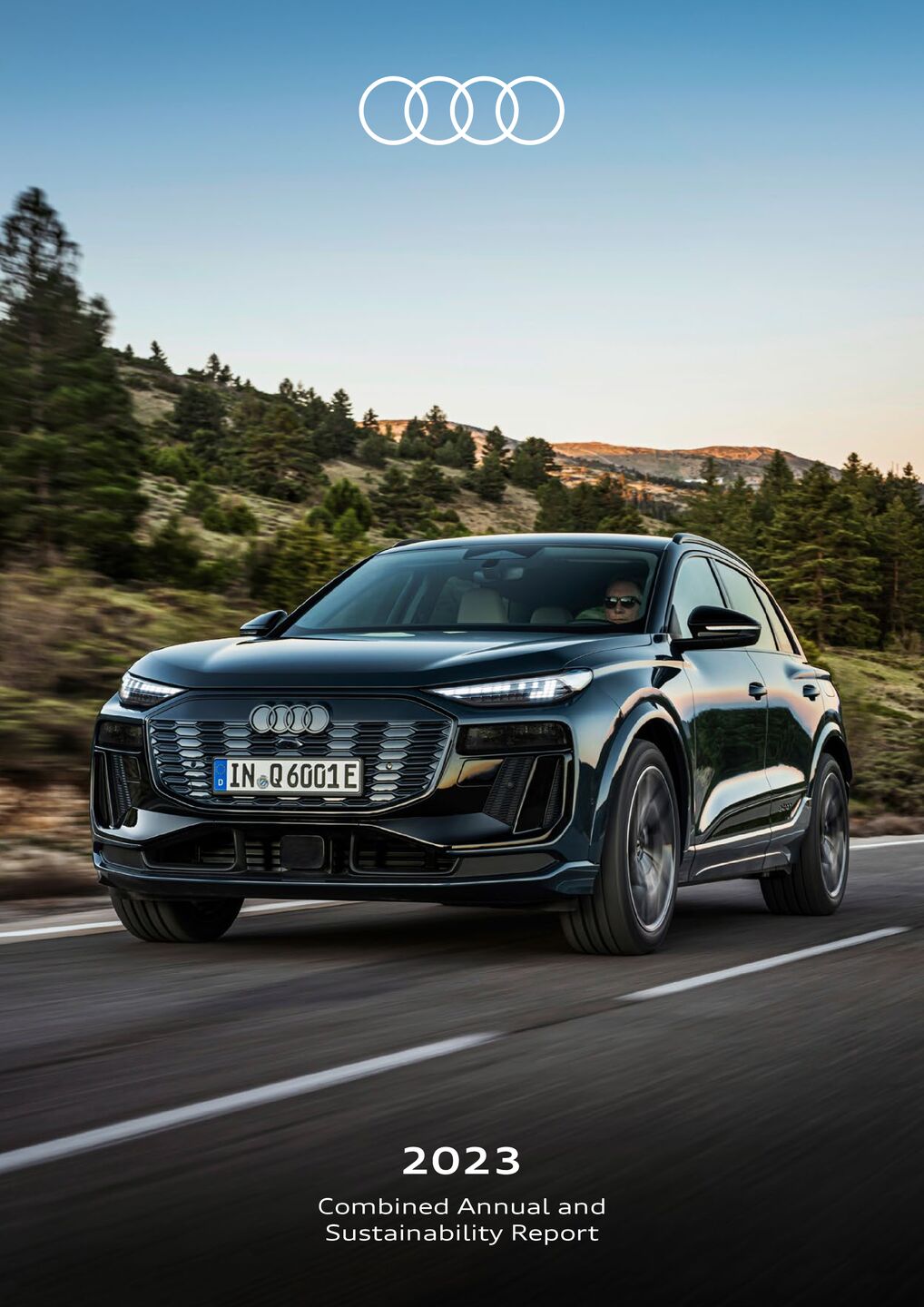 2023: Combined Annual and Sustainability Report
2023: Combined Annual and Sustainability Report
The key to this is the interaction between various components such as the suspension, steering and drive system, as well as the braking and control systems. In the future, efficien‑ cy is to be one of the differentiating features of Audi vehicles. Certain models will additionally be created to stand out from the competition through a combination of sporty performance in conjunction with quattro. And the DNA also extends to the interior, where aspects such as finish, appearance and choice of mate‑ rials – which have been Audi strengths for decades – are complemented by digital elements. The interior is increasingly becoming a platform for digital content in the vehicle. Infotainment, connectivity and intui‑ tive operation are key elements for a premium in-car experience. That is why new Audi models are being designed more than ever from the inside out and with the user in mind. The goal is clear: to ensure that cus‑ tomers have the best possible user experience across the entire portfolio in the future. Renate Vachenauer Member of the Board of Management of AUDI AG, Procurement More and more recycled materials in series-production models Stylish update: as of 2024, the Audi A3 family will present numerous digital fea‑ tures, an even sportier design and a new variant – the Audi A3 allstreet.9 9 Audi A3 allstreet: fuel consumption (combined) in l/100 km: 5.8–5.0; CO₂ emissions (combined): in g/km: 141–123 g/km; CO₂ class: E–D.Ph ot os : A U D I A G ( 2 ) 17 Audi Report 2023 Strategy & Company Finance ESG Appendix In the long term, selected models are also expected to set themselves apart by offering automated driving functions and providing passengers with completely new ways of spending their time in the vehicle. Another hallmark of future Audi models will be sustainably designed interiors – for example, through the use of materials sourced from circular economy processes.
 Audi Tradition - Anniversary Dates 2024
Audi Tradition - Anniversary Dates 2024
As well as featuring innovations like the four-link front axle or new five-valve petrol engines, it also succeeded in reversing the spiralling trend for increased weight. Every version of the A4 was much lighter than the previous model. Audi A4 Years 30 Audi Tradition 7 Anniversary Dates 2024 Years 30 Following the unveiling of the Audi A8 and the high- volume Audi A4 model, the previous Audi 100 series was also renamed the Audi A6. Although the main body was unchanged, the product was upgraded with newly designed bumpers, a new front apron, headlamp lenses that were bevelled towards the radiator grille, new indicator lights and tail lights. All models were given extra indicator lights on the side of the front fender. The side trims, door handles, external mirrors and bumpers were painted in the same colour as the car. The launch of the A6 series also heralded the end of the era of five-cylinder petrol engines. Only the five- cylinder turbo engine in the Audi S6 was retained in the range until production ended. One year after the market launch, the A6 was given newly developed, more powerful four and six-cylinder, five-valve engines with a variable-length intake manifold and, with the four-cylinder engine, variable camshaft adjustment. Almost 291,000 of the fourth C-series generation were made before the factory holidays in August 1997. Audi A6 Audi Tradition 8 Anniversary Dates 2024 At the Geneva Motor Show in March 1994, AUDI AG presented the Audi A8, its new model in the premium segment. By unveiling this car, Audi once again demonstrated the company’s capacity for innovation in the field of automotive engineering. After many years of development, it had managed to put the Audi A8 into production with a fully aluminium body. The body was based on the Audi Space Frame (ASF). This was a frame structure for the body on which individual extruded profiles were joined together by die-cast nodes.
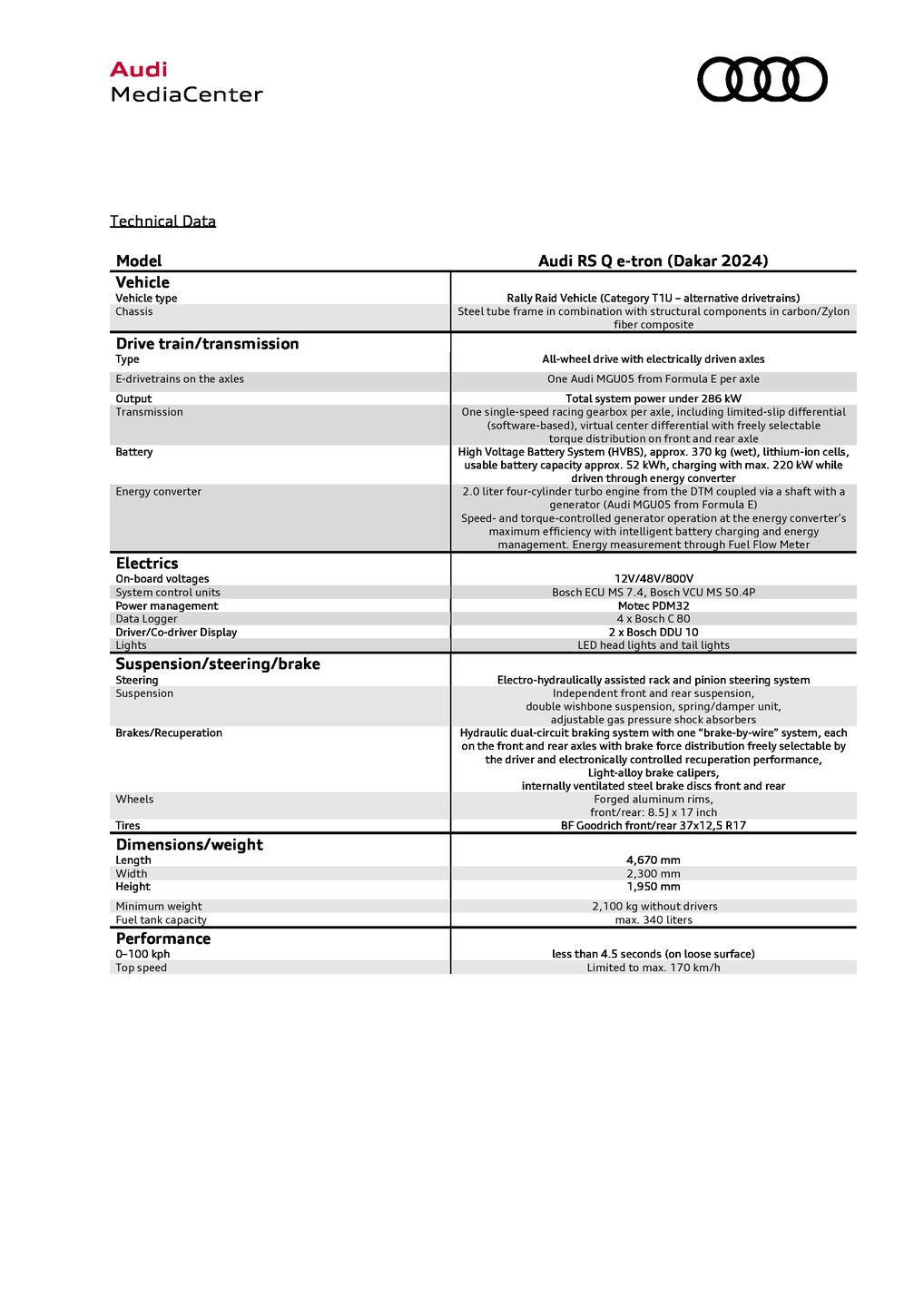 Technical Data: Audi RS Q e-tron (Dakar 2024)
Technical Data: Audi RS Q e-tron (Dakar 2024)
Audi MediaCenter Technical Data Model Audi RS Q e-tron (Dakar 2024) Vehicle Vehicle type Rally Raid Vehicle (Category T1U – alternative drivetrains) Chassis Steel tube frame in combination with structural components in carbon/Zylon fiber composite Drive train/transmission Type All-wheel drive with electrically driven axles E-drivetrains on the axles One Audi MGU05 from Formula E per axle Output Total system power under 286 kW Transmission One single-speed racing gearbox per axle, including limited-slip differential (software-based), virtual center differential with freely selectable torque distribution on front and rear axle Battery High Voltage Battery System (HVBS), approx. 370 kg (wet), lithium-ion cells, usable battery capacity approx. 52 kWh, charging with max. 220 kW while driven through energy converter Energy converter 2.0 liter four-cylinder turbo engine from the DTM coupled via a shaft with a generator (Audi MGU05 from Formula E) Speed- and torque-controlled generator operation at the energy converter’s maximum efficiency with intelligent battery charging and energy management.
 Anniversary Dates 2023
Anniversary Dates 2023
Heydekampf ................12 Autumn 1978 45 years Audi five-cylinder diesel engines ..............13 July 1973 50 years end of production of NSU Prinz 4 .............14 March 1973 50 years death of Fritz von Falkenhayn ..................15 December 1968 55 years end of production of DKW Munga, very last DKW ......................................................16 October 1963 60 years Ludwig Kraus joins Auto Union GmbH .......17 September 1963 60 years new products presented at Frankfurt IMS – NSU/Wankel Spider..............................................18 Contents Anniversaries in Our Corporate History Audi Tradition 3 Anniversary Dates 2023 September 1963 60 years new products presented at Frankfurt IMS – DKW F 12 und DKW F 12 Roadster ........................20 September 1963 60 years new products presented at Frankfurt IMS – DKW F 102 ..........................................................22 September 1963 60 years end of production of Auto Union 1000 .....23 May 1963 60 years bike production ceased in Neckarsulm ......24 April 1958 65 years takeover by Daimler-Benz, new plant, end of motorbike construction ..............................25 March 1953 70 years DKW F 91 three-cylinder model ...............27 October 1953 70 years NSU Quickly ............................................28 August 1948 75 years deletion of Auto Union AG .......................29 Spring 1933 90 years Audi Front ..............................................30 1928 95 years NSU 6/30 and NSU 7/34 .........................31 1873 150 years foundation of NSU ................................32 Audi Tradition 4 Anniversary Dates 2023 1988 35 years Audi 200 TransAm ..................................33 1983 40 years Hannu Mikkola, World Rally Champion .....34 1978 45 years Audi Motorsport .....................................35 June 1938 85 years Ewald Kluge wins the Lightweight TT on DKW ........................................36 January 1938 85 years Bernd Rosemeyer suffers fatal accident
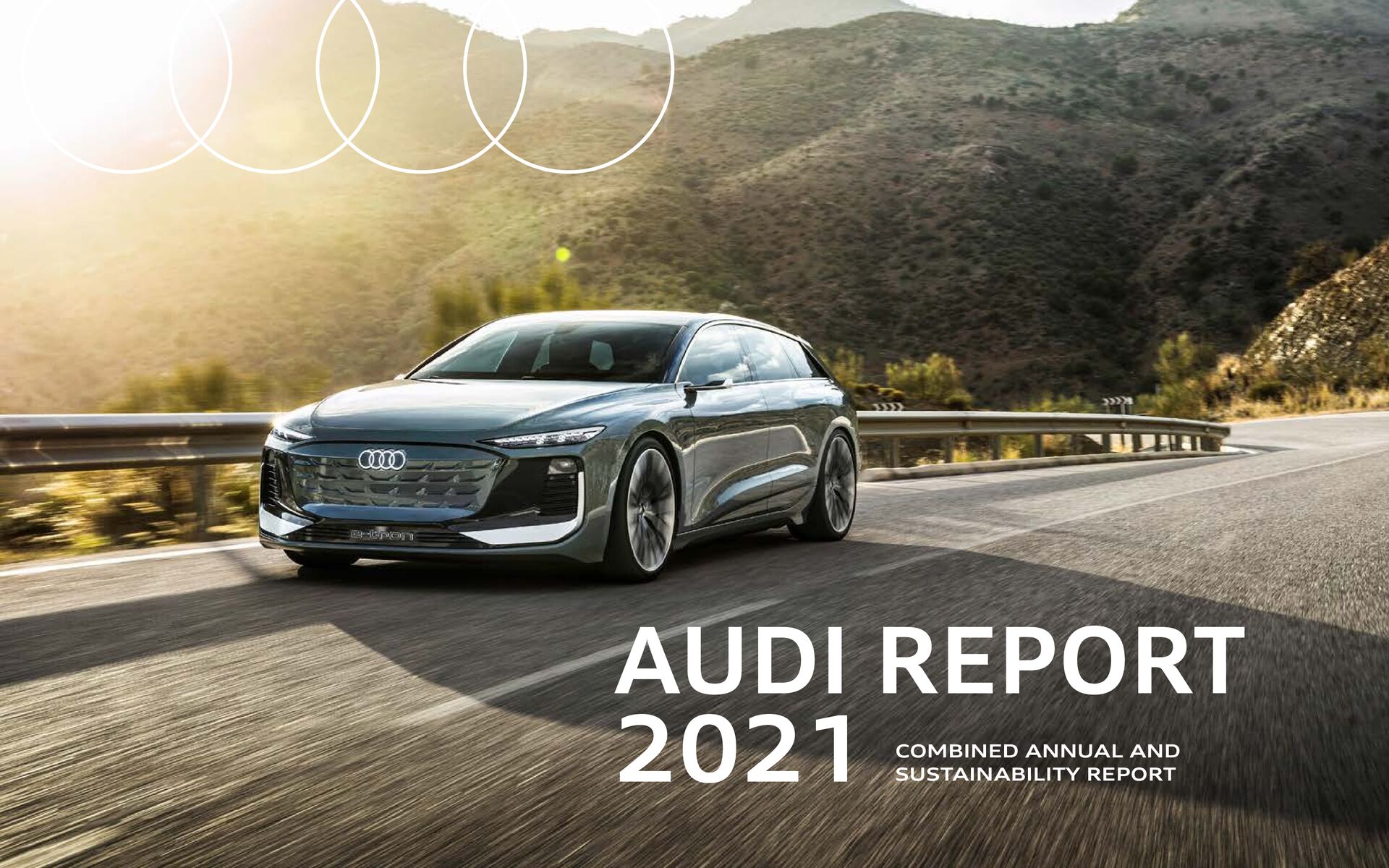 Audi Report 2021
Audi Report 2021
Close-up of semiconductor blanks: The chip crisis kept the automotive industry in suspense in 2021 and also affected production at Audi. P h o to : A U D I A G 33 38 40 36 35 42 42 48 49 50 57 58 62 63 65 66 67 Audi Report 2021 35 S trateg y P ro d u cts & S ervices O p eratio n s & In teg rity V alu e C reatio n & P ro d u ctio n E m p lo yees & S o ciety A p p en d ix In tro d u ctio n Semiconductor shortages impacted the 2021 fiscal year Despite intensive crisis management, semiconductor shortages made production adjustments necessary. How Audi responded to this crisis: Function of semiconductors Semiconductors are an indispensable part of modern vehicles. They are used primarily in complex control units. In addition to standard components, they contain a significant portion of specially developed integrated circuits. Figuratively speaking, these microprocessors are the brain of a car and handle, for example, control functions for driver assistance systems, connectivity services and infotainment functions. Current Audi models sometimes use more than 100 connected control units. These comprise several thousand semiconductors. A significant shortage of semiconductors has been leading to supply bottlenecks in industry globally since the beginning of 2021. The automotive industry has also felt the effects of this undersupply, which was triggered, among other things, by factory closures at key manufacturers as a result of the pandemic. Audi consequently also had to cut production, leading to temporary short-time work at the German sites. Product adjustments and reductions in stocks stabilize deliveries Since the beginning of 2021, Audi has been working relentlessly in company-wide crisis teams and in close collaboration with the Volkswagen Group to limit the impact of the semiconductor shortage.
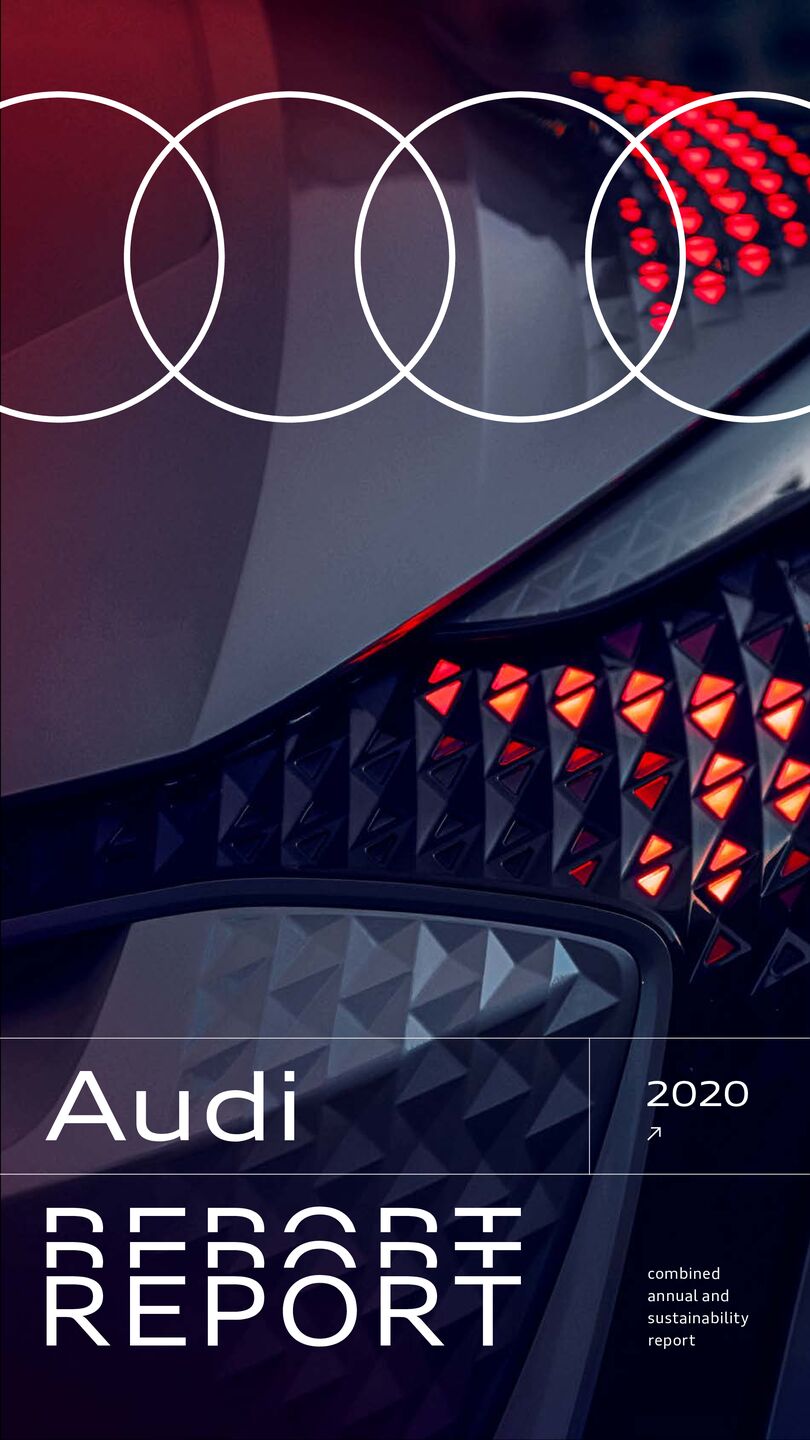 Audi Report 2020
Audi Report 2020
Governments and central banks in numerous countries responded with monetary and fiscal policy measures, sometimes on a vast scale, such as dramatic cuts in interest rates, the suspension of social security contributions, short-time work and direct financial support payments. Economic development in core markets: Europe – USA – China The economy in Europe recorded a sharp contraction of –6.7 (1.5) percent overall in 2020. This was due, among other things, to national measures to contain the pandemic. The severe restrictions on public life had a serious impact on the service sector, for example, which was the bedrock of the economy before the pandemic. Governments in many European countries The world economy recorded negative growth in the 2020 fiscal year as a result of the global impacts of the coronavirus pandemic. Total global demand for vehicles was markedly lower than in the previous year. Audi Report 2020 86 Operations & Integrity eased the restrictions for a time, which led to a gradual economic recovery. Later in the year, with cases increasing again, some of these measures were tightened up again or at least kept in place. The uncertain outcome of the negotiations concerning the exit of the United Kingdom from the European Union (EU) also continued to generate uncertainty in the 2020 fiscal year, as did the related question of what form the economic relationship would take in the future. At –5.3 (0.6) percent, Germany’s economic growth in the year under review was well into negative territory. US economic output fell by –3.6 (2.2) percent in the year under review due to high infection rates. The US government agreed extensive support packages to bolster the economy. Meanwhile, in addition to further action to support the economy, the Federal Reserve cut interest rates twice. The Chinese economy was hit by the negative effects of the coronavirus pandemic earlier than others.
 Audi RS 3 LMS at a glance
Audi RS 3 LMS at a glance
Audi RS 3 LMS World premiere 2021 TCR touring cars: regulations Vehicle type Touring car according to FIA Group A Minimum number of units produced of the corresponding model: 5,000, assembled in 12 consecutive months Body Minimum length 4.20 meters, maximum width 1.95 meters, 4 or 5 doors Engine Four-stroke gasoline engine, one turbocharger Displacement 1.75 to 2 liters Use of a maximum of one engine and up to five turbochargers per sprint season Power transmission Front-wheel drive Cost control Prohibition of telemetry, driving aids, materials such as titanium, magnesium, ceramics. Certification of homologation frozen for 3 years Equal opportunities Common engine control unit Balance of performance by defining engine power output, weight, ride height TCR racing worldwide Racing series for TCR models 38 Countries worldwide 31 Continents 5 Number of races 1,051 Number of starts 3,105 Podium finishes 764 Wins 279 Thereof 24h race wins 5 Second places 252 Third places 233 Driver titles 16 Further titles 38 Roll of honor up to 2020 Comparison of generations Premiere September 29, 2016, Mondial de l’Automobile Paris Market launch Week 50/2016 First win January 14, 2017, Dubai 24 Hours, TCR class win Production Győr (H): body Győr (H): engine Martorell (E): assembly of race car Premiere February 5, 2021, Neuburg a. d.
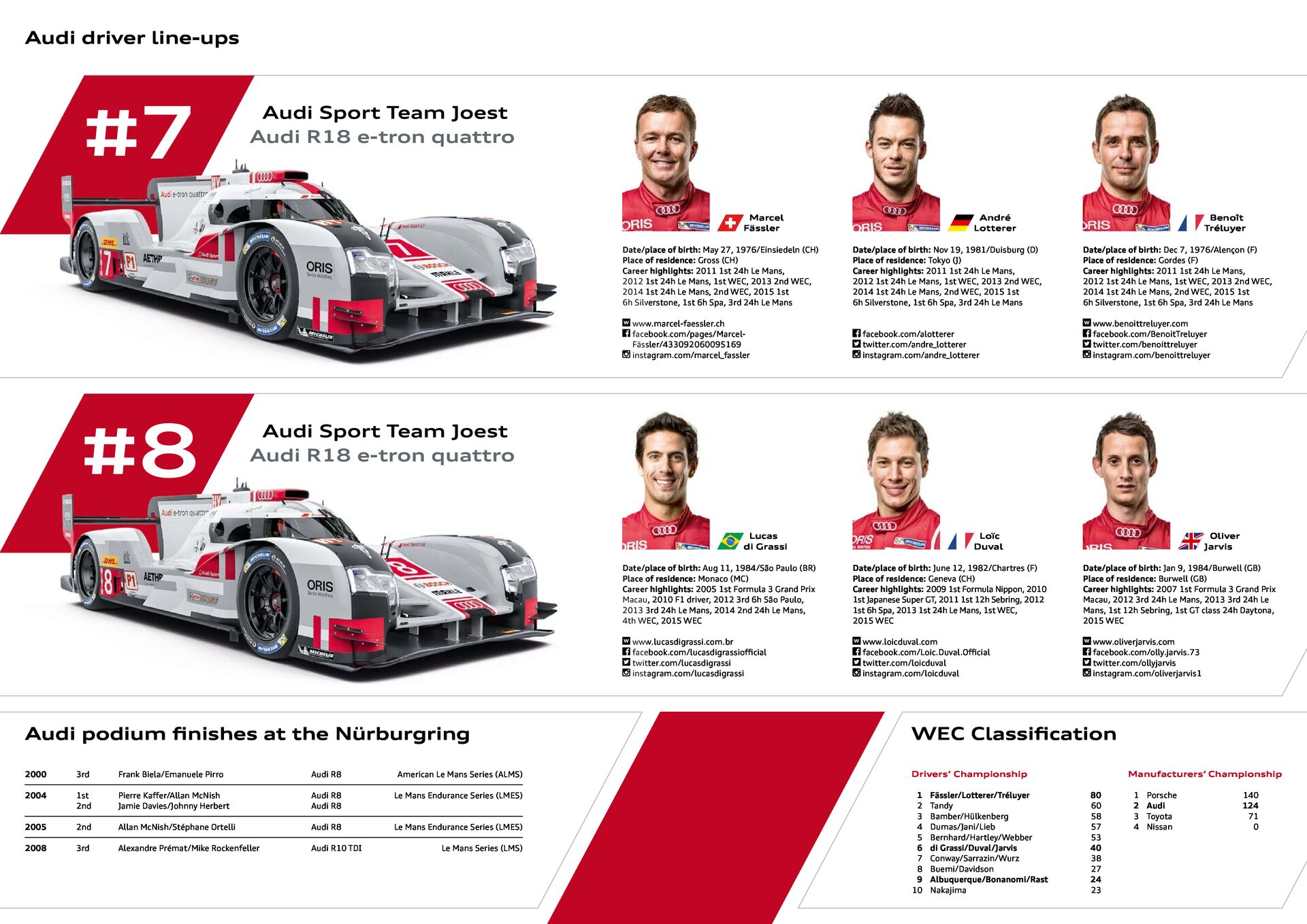 Media Z-Card WEC Nürburgring 2015
Media Z-Card WEC Nürburgring 2015
www.benoittreluyer.com facebook.com/BenoitTreluyer twitter.com/benoittreluyer instagram.com/benoittreluyer Date/place of birth: Jan 9, 1984/Burwell (GB) Place of residence: Burwell (GB) Career highlights: 2007 1st Formula 3 Grand Prix Macau, 2012 3rd 24h Le Mans, 2013 3rd 24h Le Mans, 1st 12h Sebring, 1st GT class 24h Daytona, 2015 WEC w www.oliverjarvis.com facebook.com/olly.jarvis.73 twitter.com/ollyjarvis instagram.com/oliverjarvis1 Audi podium fi nishes at the Nürburgring WEC Classifi cation Audi driver line-ups Audi Sport Team Joest Audi R18 e-tron quattro Audi Sport Team Joest Audi R18 e-tron quattro #7 #8 Marcel Fässler André Lotterer Benoît Tréluyer Lucas di Grassi Loïc Duval Oliver Jarvis 272 7 200 5 72 1 100 2 255 690 2 105 2 105 2 275 7 120 2 200 5 74 1 230 6 110 2 200 5 220 5 260 7 78 1 130 3 240 6 145 3 km/h Gear Media contact Audi Communications Motorsport Eva-Maria Veith +49 173 939 35 22 eva-maria.veith@audi.de www.audi-motorsport.info Social media Facebook facebook.com/AudiSport Twitter twitter.com/Audi__Sport Instagram instagram.com/audi__sport Event schedule Friday, August 28 12:00–13:30 Free Practice 1 15:00 Press conference 16:30–18:00 Free Practice 2 Saturday, August 29 14:00–14:20 Qualifying LMGTE 14:30–14:50 Qualifying LMP 15:00 Press conference 16:30–17:30 Meet the Team in the Audi Team & Media Hospitality Sunday, August 30 13:00–19:00 Race 19:15 Press conference Speeds and gears Vehicle Vehicle type Le Mans Prototype (LMP1) Monocoque Carbon fi ber composite (CFC), aluminum honeycomb structure, Zylon side panels, rear CFC crasher Battery Lithium ion battery Engine Engine type Audi TDI, turbocharged 120 degree V6, 4 valves per cylinder, 1 Garrett VTG turbocharger, diesel direct injection TDI, fully stressed aluminum crankcase Cubic capacity 4,000 cc Power output Over 410 kW (558 hp) Torque Over 850 Nm Hybrid system Type of accumulator Electric fl ywheel accumulator, WHP, usable storage capacity over 700 kJ Motor Generator Unit (MGU) One MGU on front